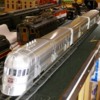I use .stl files but you can use .obj files.
The print quality is not dependent on the file type that I understand.
It's dependent on your printer's resolution capability such as the layer thickness.
The higher the resolution, the more detailed your object will be. There are three dimensions to consider: the two planar 2D dimensions (X and Y) and the Z dimension that makes it 3D printing.
Since 3D printers produce parts in 3 dimensions, you will have to consider at least two numbers: the minimum feature size of the XY plane and the Z-axis resolution (layer thickness or layer height). The Z-axis resolution is easily determined and therefore widely reported even though it is less related to print quality and surface finish. The more important XY resolution (minimum feature size) is measured via microscopic imaging and is therefore not always found in spec sheets.
The FormLabs 3 layer thickness is 25 – 300 microns (.001 – .012 in.).
Elegoo Mars 3 Layer Thickness: 10 -200 microns (.0004 - .008 in)
So from this spec, it looks like the Elegoo M3 has better resolution that the FL. However, you need to look at the laser spot size and xY resolution too.
FL3 XY Resolution 25 microns 0.001 in , Laser Spot Size 85 microns 0.0033 in.
Elegoo says XY resolution is around 50 microns 0.05 mm. no spot size given.
Even so 50 microns will still get you a nicely detailed part and you need to compare what those other 25 microns cost you to get there with the FL3.
Based on the size of the tiny parts I have been making recently I need the 25 micron XY resolution. You may not!





